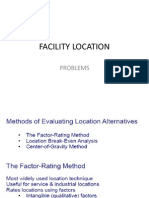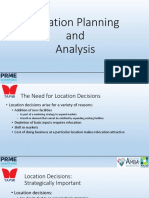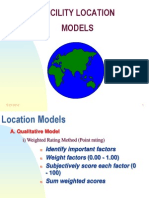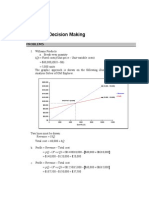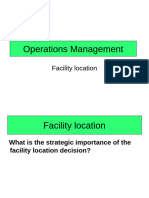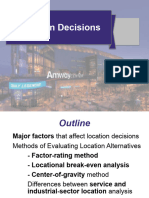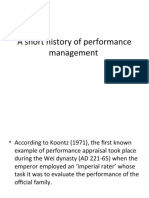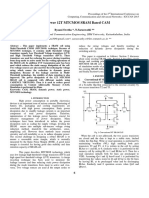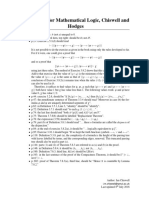Factor Rating
Factor Rating
Uploaded by
Tesfaye KebedeCopyright:
Available Formats
Factor Rating
Factor Rating
Uploaded by
Tesfaye KebedeCopyright
Available Formats
Share this document
Did you find this document useful?
Is this content inappropriate?
Copyright:
Available Formats
Factor Rating
Factor Rating
Uploaded by
Tesfaye KebedeCopyright:
Available Formats
Factor Rating
A typical location decision involves both qualitative and quantitative inputs,
which tend to vary from situation to situation depending on the needs of each
organization. Factor rating is a general approach that is useful for evaluating
a given alternative and comparing alternatives. The value of factor rating is
that it provides a rational basis for evaluation and facilitates comparison
among alternatives by establishing a composite value for each alternative that
summarizes all related factors. Factor rating enables decision makers to
incorporate their personal opinions and quantitative information into the
decision process.
The following procedure is used to develop a factor rating.
1. Determine which factors are relevant (e.g., location of market, water
supply, parking facilities, revenue potential).
2. Assign a weigh to each factor that indicates its relative importance
compared with all other factors. Typically, weights sum to 1.00.
3. Decide on a common scale for all factors (e.g., 0 to 100).
4. Score each location alternative.
5. Multiply the factor weight by the score for each factor, and sum the
results for each location alternative.
6. Choose the alternative that has the highest composite score.
This procedure is illustrated in the next example.
A photo-processing company intends to open a new branch store. The table
below contains information on two potential locations.
(Scores)
(Out of 100) Weighted Scores
Factor Weight Alt. 1 Alt.2 Alternative 1 Alternative 2
Proximity to existing store .10 100 60 .10(100)=10.0 .10(60)=6.0
Traffic volume .05 80 80 .05(80)=4.0 .05(80)=4.0
Rental costs .40 70 90 .40(70)=28.0 .40(90)=36.0
Size .10 86 92 .10(86)=8.6 .10(92)=9.2
Layout .20 40 70 .20(40)=8.0 .20(70)=14.0
Operating costs .15 80 90 .15(80)=12.0 .15(90)=13.5
1.00 70.6 82.7
Alternative 2 is better because it has the higher composite score.
In some cases, managers may prefer to establish minimum thresholds for
composite scores. If an alternative fails to meet that minimum, they can reject
it without further consideration. If none of the alternatives meets the
minimum, this means that either additional alternatives must be identified and
evaluated or the minimum threshold must be reevaluated.
The Center of Gravity Method
The center of gravity method is a method to determine the location of a
distribution center that will minimize distribution costs. It treats distribution
cost as a linear function of the distance and the quantity shipped. The
quantity to be shipped to each destination is assumed to be fixed (i.e., will not
change over time). An acceptable variation is that quantities are allowed to
change, as long as their relative amounts remain the same (e.g., seasonal
variations).
The center of gravity method is a technique for locating single facilities that
considers the existing facilities, the distances between them, and the volumes
of goods to be shipped.
The technique is often used to locate intermediate or distribution
warehouses.
The center of gravity method begins by placing the existing locations on a
coordinate grid system.
The purpose is to establish relative distances between locations.
The center of gravity is found by calculating the X and Y coordinates that
result in the minimal transportation cost.
We use the formulas
Cx= ∑dix Vi
∑ Vi
Cy= ∑diy Vi
Cx= ∑ Vi
where
Cx= X Coordinate of the center of gravity
Cy=Y Coordinate of the center of gravity
dix= X Coordinate of the ith location
diy= Y Coordinate of the ith location
Vi= Volume of goods to or from the ith location
Example: A refining company needs to locate an intermediate holding facility
between its refining plant in place A and its major distributors. The following
exhibit shows the coordinate map.
500
E(25,450)
400 D(350,400)
C(450,350)
300
200 * Center of gravity (308,217)
B(400,150)
100
A(325,75)
o
o 100 200 300 400 500
Plant
Distributor
Shipping Volumes
Locations A B C D E
Gallons of Gasoline per month (000,000) 1,500 250 450 350 450
In this example, for location A d1x = 325, d1y = 75, and V1=1,500
Solution: using the above information we can calculate the coordinates of the
center of gravity.
Cx= (325x1,500) + (400x250) + (450x450)+(350x350)+(25x450) = 923,750 = 307.9
1,500 + 250+ 450+350+450 3,000
Cy= (75x1,500) + (150x250) + (350x450)+(400x350)+(450x450) = 65,000 = 216.7
1,500 + 250+ 450+350+450 3,000
You might also like
- Angels Ghosts Demons Gods Aliens and Entities 1 1100% (1)Angels Ghosts Demons Gods Aliens and Entities 1 142 pages
- Location Planning and Analysis Charly Mint A. Israel: Mcgraw-Hill/IrwinNo ratings yetLocation Planning and Analysis Charly Mint A. Israel: Mcgraw-Hill/Irwin23 pages
- Chapter 2 4 Facilities Location MethodsNo ratings yetChapter 2 4 Facilities Location Methods23 pages
- Operations Management: Location StrategiesNo ratings yetOperations Management: Location Strategies22 pages
- Facility Location: Issues in Facility Location Various Plant Location MethodsNo ratings yetFacility Location: Issues in Facility Location Various Plant Location Methods12 pages
- Production and Operational Management: Facility LocationNo ratings yetProduction and Operational Management: Facility Location34 pages
- Indicative Answers:: N12405 MAD II Seminar 3 Activity-Based CostingNo ratings yetIndicative Answers:: N12405 MAD II Seminar 3 Activity-Based Costing2 pages
- CH 4 Process Selection and Facility LayoutNo ratings yetCH 4 Process Selection and Facility Layout24 pages
- Facility Location: Presented By:-Fedora - 76 Sharon-111 Manisha-114 Malcolm-89 Roshan-106No ratings yetFacility Location: Presented By:-Fedora - 76 Sharon-111 Manisha-114 Malcolm-89 Roshan-10644 pages
- 4.3 (Facility Location, Facility Capacity and Facility Layout Planning)No ratings yet4.3 (Facility Location, Facility Capacity and Facility Layout Planning)10 pages
- FALLSEM2023-24 MEE1014 TH VL2023240101810 2023-10-03 Reference-Material-INo ratings yetFALLSEM2023-24 MEE1014 TH VL2023240101810 2023-10-03 Reference-Material-I12 pages
- Classification, Parameter Estimation and State Estimation: An Engineering Approach Using MATLABFrom EverandClassification, Parameter Estimation and State Estimation: An Engineering Approach Using MATLAB3/5 (1)
- A Short History of Performance ManagementNo ratings yetA Short History of Performance Management17 pages
- 2 An Introduction To Electronic and Ionic MaterialsNo ratings yet2 An Introduction To Electronic and Ionic Materials4 pages
- Feasibilty Report of Accra Sports StadiumNo ratings yetFeasibilty Report of Accra Sports Stadium20 pages
- NCV-Level 3-Electrical Workmanship-12041013-Student Guide-2016No ratings yetNCV-Level 3-Electrical Workmanship-12041013-Student Guide-201617 pages
- Dive Xtras X-Scooter Series Owner S ManualNo ratings yetDive Xtras X-Scooter Series Owner S Manual23 pages
- Matatag K To 10 School Mendez Elementary School Grade Four Teacher Kristel Marie L. Larraquel Subject A.P Date/Day July 29,2024 Monday Quarter 1No ratings yetMatatag K To 10 School Mendez Elementary School Grade Four Teacher Kristel Marie L. Larraquel Subject A.P Date/Day July 29,2024 Monday Quarter 14 pages
- Metals: Charpy Impact Properties of Hydrogen-Exposed 316L Stainless Steel at Ambient and Cryogenic TemperaturesNo ratings yetMetals: Charpy Impact Properties of Hydrogen-Exposed 316L Stainless Steel at Ambient and Cryogenic Temperatures14 pages
- Zhang et al. 2024. Biological fermentation pilot-scale systems and evaluation for commercial viability towards sustainable biohydrogenNo ratings yetZhang et al. 2024. Biological fermentation pilot-scale systems and evaluation for commercial viability towards sustainable biohydrogen12 pages
- Land Suitability Analysis Using Multi Attribute deNo ratings yetLand Suitability Analysis Using Multi Attribute de6 pages
- Yale Global King A-Frame Wire Rope Hoist 2014 Sept 11817505 Rev ABNo ratings yetYale Global King A-Frame Wire Rope Hoist 2014 Sept 11817505 Rev AB52 pages
- Solairedirect Energy India Private LimitedNo ratings yetSolairedirect Energy India Private Limited6 pages
- Location Planning and Analysis Charly Mint A. Israel: Mcgraw-Hill/IrwinLocation Planning and Analysis Charly Mint A. Israel: Mcgraw-Hill/Irwin
- Facility Location: Issues in Facility Location Various Plant Location MethodsFacility Location: Issues in Facility Location Various Plant Location Methods
- Production and Operational Management: Facility LocationProduction and Operational Management: Facility Location
- Indicative Answers:: N12405 MAD II Seminar 3 Activity-Based CostingIndicative Answers:: N12405 MAD II Seminar 3 Activity-Based Costing
- Facility Location: Presented By:-Fedora - 76 Sharon-111 Manisha-114 Malcolm-89 Roshan-106Facility Location: Presented By:-Fedora - 76 Sharon-111 Manisha-114 Malcolm-89 Roshan-106
- 4.3 (Facility Location, Facility Capacity and Facility Layout Planning)4.3 (Facility Location, Facility Capacity and Facility Layout Planning)
- FALLSEM2023-24 MEE1014 TH VL2023240101810 2023-10-03 Reference-Material-IFALLSEM2023-24 MEE1014 TH VL2023240101810 2023-10-03 Reference-Material-I
- Classification, Parameter Estimation and State Estimation: An Engineering Approach Using MATLABFrom EverandClassification, Parameter Estimation and State Estimation: An Engineering Approach Using MATLAB
- 2 An Introduction To Electronic and Ionic Materials2 An Introduction To Electronic and Ionic Materials
- NCV-Level 3-Electrical Workmanship-12041013-Student Guide-2016NCV-Level 3-Electrical Workmanship-12041013-Student Guide-2016
- Matatag K To 10 School Mendez Elementary School Grade Four Teacher Kristel Marie L. Larraquel Subject A.P Date/Day July 29,2024 Monday Quarter 1Matatag K To 10 School Mendez Elementary School Grade Four Teacher Kristel Marie L. Larraquel Subject A.P Date/Day July 29,2024 Monday Quarter 1
- Metals: Charpy Impact Properties of Hydrogen-Exposed 316L Stainless Steel at Ambient and Cryogenic TemperaturesMetals: Charpy Impact Properties of Hydrogen-Exposed 316L Stainless Steel at Ambient and Cryogenic Temperatures
- Zhang et al. 2024. Biological fermentation pilot-scale systems and evaluation for commercial viability towards sustainable biohydrogenZhang et al. 2024. Biological fermentation pilot-scale systems and evaluation for commercial viability towards sustainable biohydrogen
- Land Suitability Analysis Using Multi Attribute deLand Suitability Analysis Using Multi Attribute de
- Yale Global King A-Frame Wire Rope Hoist 2014 Sept 11817505 Rev ABYale Global King A-Frame Wire Rope Hoist 2014 Sept 11817505 Rev AB














